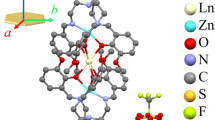Abstract
The DyIII ions in the dimer [Dy2(H2tea)2(O2CPh)4]·2H2O (1) (H3tea = triethanolamine) have the 9-coordinate monocapped square-antiprismatic ligand field environment. Compound 1 shows slow relaxation of magnetization which is observable only with applied magnetic fields. This is consistent with the idea that low-symmetry ligand fields allow for the quantum tunneling of magnetization. This is reflected by the fact that there are no observable maxima in the out-of-phase ac susceptibility above 1.8 K. The {g}-tensor of the DyIII ions {g x = 11, g y = 8.2, g z = 1} further underlying the reduced uniaxiality in this system was determined in electron paramagnetic resonance (X- and Q-band) studies of 1 at temperatures down to 4 K.






Similar content being viewed by others
Notes
Crystal data for 1: C40H52Dy2N2O16, 1141.83 g mol−1, triclinic, P \(^{\bar{1}}\), a = 10.0767(17), b = 10.7338(18), c = 10.8695(18) Å, α = 74.189(2), β = 75.521(3), γ = 67.417(2) °, Z = 1, V = 1030.4(3) Å3, T = 100(2) K, ρ calc = 1.840 g cm−3, F(000) = 566, μ(Mo-Kα) = 3.674 mm−1; 30,564 data, 5188 unique (R int = 0.0247), 285 parameters, final wR 2 = 0.0451, S = 1.068 (all data), R 1 (5060 data with I > 2σ(I)) = 0.0181, max. Peak/hole in final difference map +0.982/−0.503 e Å−3. CCDC 1497473.
References
N. Ishikawa, M. Sugita, T. Ishikawa, S.-Y. Koshihara, Y. Kaizu, J. Am. Chem. Soc. 125, 8694–8695 (2003)
J.D. Rinehart, J.R. Long, Chem. Sci. 2, 2078–2085 (2011)
N.F. Chilton, D. Collison, E.J.L. McInnes, R.E.P. Winpenny, A. Soncini, Nat. Commun. 4, 2551 (2013)
L. Sorace, C. Benelli, D. Gatteschi, Chem. Soc. Rev. 40, 3092–3104 (2011)
D.N. Woodruff, R.E.P. Winpenny, R.A. Layfield, Chem. Rev. 113, 5110–5148 (2013)
J. Long, F. Habib, P.H. Lin, I. Korobkov, G. Enright, L. Ungur, W. Wernsdorfer, L.F. Chibotaru, M. Murugesu, J. Am. Chem. Soc. 133, 5319–5328 (2011)
J.D. Rinehart, M. Fang, W.J. Evans, J.R. Long, Nat. Chem. 3, 538–542 (2011)
F. Habib, P.H. Lin, J. Long, I. Korobkov, W. Wernsdorfer, M. Murugesu, J. Am. Chem. Soc. 133, 8830–8833 (2011)
Y.-N. Guo, G.-F. Xu, W. Wernsdorfer, L. Ungur, Y. Guo, J. Tang, H.-J. Zhang, L.F. Chibotaru, A.K. Powell, J. Am. Chem. Soc. 133(2011), 11948–11951 (1951)
E.M. Fatila, M. Rouzières, M. Jennings, A.J. Lough, R. Clérac, K.E. Preuss, J. Am. Chem. Soc. 135, 9596–9599 (2013)
R.J. Blagg, L. Ungur, F. Tuna, J. Speak, P. Comar, D. Collison, W. Wernsdorfer, E. J. L.McInnes, L.F. Chibotaru, R. E. P. Winpenny, Nat. Chem. 5, 673–678 (2013)
T. Fukuda, K. Matsumura, N. Ishikawa, J. Phys. Chem. A. 117, 10447–10454 (2013)
E.M. Pineda, N.F. Chilton, R. Marx, M. Dorfel, D.O. Sells, P. Neugebauer, Sh-D Jiang, D. Collison, J. van Slageren, E.J.L. Mclnnes, R.E.P. Winpenny, Nat. Commun. 5, 5243 (2014)
P. Parios, S.A. Moggach, A.R. Lennie, J.E. Warren, E.K. Brechin, M. Murrie, S. Parsons, Dalton. Trans. 39, 7004–7011 (2010)
J.M. Baker, Proc. R. Soc. Lond. 413, 515–528 (1987)
A. Abragam, B. Bleaney, Electron Paramagnetic Resonance of Transition Ions (Clarendon, Oxford, 1970)
A. Bencini, D. Gatteschi, Electron Paramagnetic Resonance of Exchange Coupled Systems (Springer, Berlin, 1990), p. 287
A. Baniodeh, Ya. Lan, Gh. Novitchi, V. Mereacre, A. Sukhanov, M. Ferbinteanu, V. Voronkova, C.E. Anson, A.K. Powell, Dalton Trans. 42, 8926–8938 (2013)
Y.F. Bi, X.T. Wang, W.P. Liao, X.W. Wang, R.P. Deng, H.J. Zhang, S. Gao, Inorg. Chem. 48, 11743 (2009)
G. Abbas, Y. Lan, G.E. Kostakis, W. Wernsdorfer, C.E. Anson, A.K. Powell, Inorg. Chem. 49, 8067 (2010)
L. Ungur, L.F. Chibotaru, Phys. Chem. Chem. Phys. 13(45), 20086–20090 (2011)
G. Cucinotta, M. Perfetti, J. Luzon, M. Etienne, P.-E. Car, A. Caneschi, G. Calvez, K. Bernot, R. Sessoli, Angew. Chem. Int. Ed. 51, 1606–1610 (2012)
Y.-N. Guo, G.-F. Xu, Y. Guo, J. Tang, Dalton. Trans. 40, 9953–9963 (2011)
P.-E. Car, M. Perfetti, M. Mannini, A. Favre, A. Caneschi, R. Sessoli, Chem. Commun. 47, 3751–3753 (2011)
S. Misra, Y. Chang, J. Felsteinert, J. Phys. Chem. Solids 58(1), 1–11 (1997)
M.L. Kahn, R. Ballou, P. Porcher, O. Kahndagger, J.-P. Sutter, Chem. Eur. J. 8, 525 (2002)
J. Luzon, K. Bernot, I.J. Hewitt, C.E. Anson, A.K. Powell, R. Sessoli, Phys. Rev. Lett. 100, 247205 (2008)
K. Bernot, J. Luzon, L. Bogani, M. Etienne, C. Sangregorio, M. Shanmugam, A. Caneschi, R. Sessoli, D. Gatteschi, J. Am. Chem. Soc. 131, 5573–5579 (2009)
K. Bernot, J. Luzon, A. Caneschi, D. Gatteschi, R. Sessoli, L. Bogani, A. Vindigni, A. Rettori, M.G. Pini, Phys. Rev. B. 79, 134419 (2009)
Acknowledgements
This work was supported by the DFG-funded transregional collaborative research center SFB/TRR 88 “3MET”. This research was further supported in part by the Russian Foundation for Basic Research (project no. 13-02-01157). RG, AS and VV thank Professor Kev Salikhov for useful discussion and Program of Presidium RAS for support. AB and AKP thank the HGF Program STN for support.
Author information
Authors and Affiliations
Corresponding author
Rights and permissions
About this article
Cite this article
Baniodeh, A., Mondal, A., Galeev, R. et al. How Far can the Anisotropy Deviate from Uniaxiality in a Dy-Based Single-Molecule Magnet? Dinuclear Dy(III) Complex Study. Appl Magn Reson 48, 101–113 (2017). https://doi.org/10.1007/s00723-016-0852-y
Received:
Revised:
Published:
Issue Date:
DOI: https://doi.org/10.1007/s00723-016-0852-y




